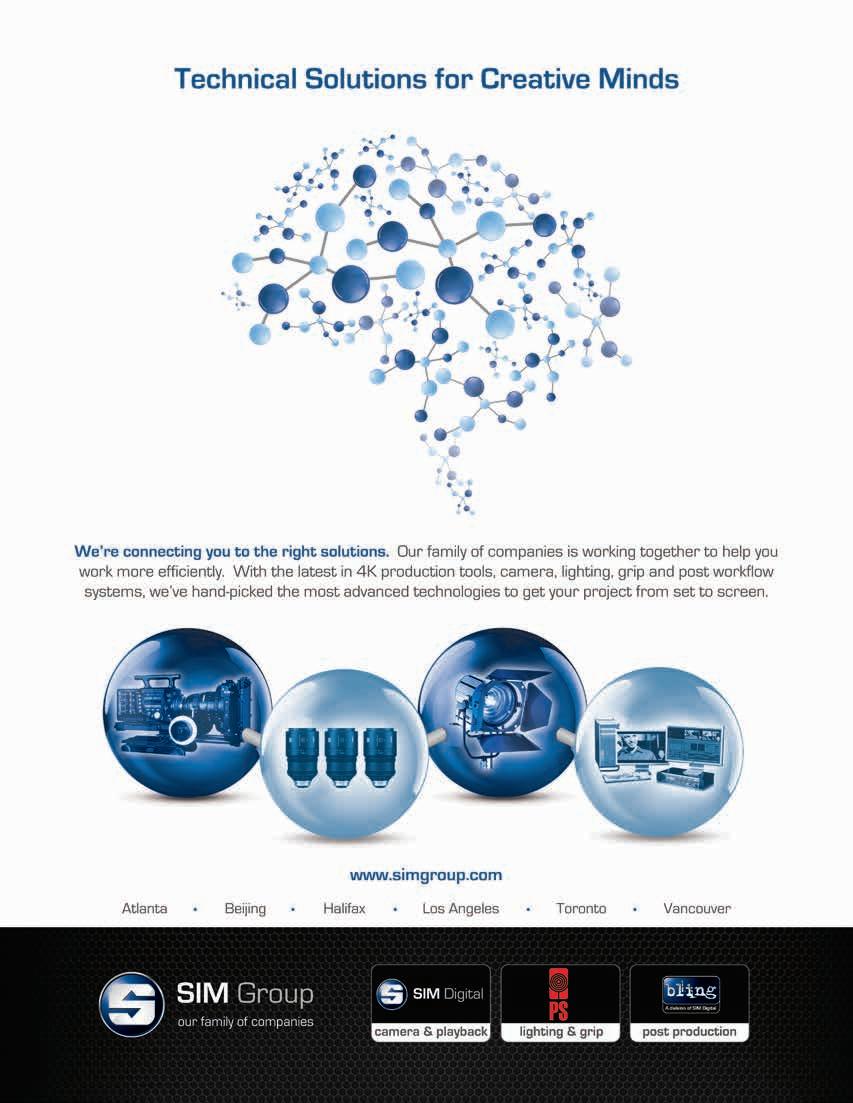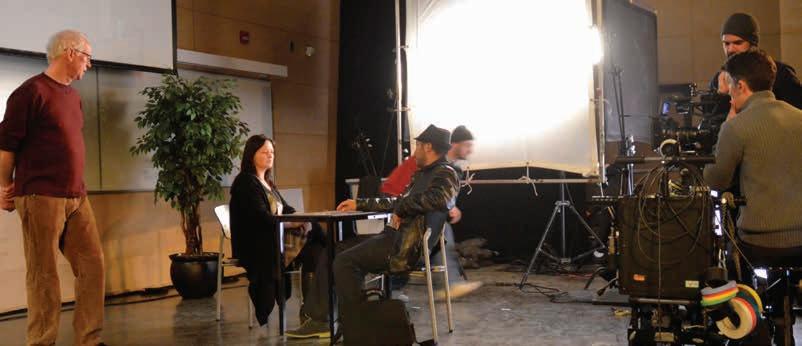
7 minute read
Acting With the Camera Workshop
D. Gregor Hagey csc with camera.
CSC’s Acting With the Camera Workshop Focuses Attention on the Lens
Written and photographed by IAN HARVEY
They’re rolling. Do you know where your lens is? Better yet, your light?
ACTRA Toronto members got a hands-on walkthrough of their craft from the DP and camera department perspective at a CSC-sponsored event February 18 at the Ted Rogers School of Business in Toronto. The event was part of ACTRA Toronto’s 2015 Winter Conference. Led by director Phil Earnshaw csc, whose body of work includes both Degrassi series, Traders, The Border and Being Erica, the two- hour seminar focused on being camera savvy, as well as set etiquette, and was based on the full-day version of the CSC’s Acting With Cameras workshop, which will take place July 11 this year. “Remember, the camera department is your best friend on the set,” said Earnshaw, who was joined by fellow DP D. Gregor Hagey csc. “The camera operator, the focus puller, cable puller, second camera assistant, even the guy on the dolly, are there to make you look good. That’s their job.” The camera isn’t just a piece of equipment around which the actors’ performance happens, the audience of some 200 people were told. It’s an essential player on the same stage that demands interaction as much as any other character in the script or the setting itself. Earnshaw ran through the basics, covering different focal lengths and how they frame the shot, being cognizant of your light, what the axis is and how the eye-line plays to the shot. The first thing all actors have to realize is that the lens’ focal length has an immediate impact on their performance because it dictates what they can and cannot do, he said. “If it’s a wide shot, save the tears for later because the camera can’t see them,” he said. “If it’s a long lens, small side-to-side movements are maybe okay – depending if it’s a cowboy shot (three-quarters to the gun belt) or medium close or even close-up – but no back-and-forth movement because you may only have a quarter inch of depth of field, and you’ll be out of focus.” Hitting the mark is a basic must for any actor, but as

Earnshaw, left, watches workshop participants.

Earnshaw noted: “Use your muscle memory to know where the mark is; don’t walk into the shot looking at your feet! It may have worked for Spencer Tracy – who walked into a shot looking down and around – but you need to know where your mark is without looking.” In shot blocking, Earnshaw said, it’s important for the actors to know where their eyes are going to focus because it will anchor the scene. “First, know where your lens is,” he said. “You have to see your lens on your camera because if you can’t see it, the camera can’t see you either. And make sure you can see the lens with two eyes not just one, which means you are really in the shot.” That’s important, especially in crowd scenes, he said, because the actor must always interact with the camera and that clearly starts with being able to be in the shot not just partially obscured in the frame. Then, he said, decide where you’re going to look. Choose a fixed spot for continuity and keep coming back to it in subsequent takes and reaction shots. Depending on the camera angle and set-up, it should be either the left eye of the actor with whom the dialogue is taking place, or the right eye, or even a point at the camera. It’s something you can work out with the DP or camera operator quickly without taking up much time. During blocking, it’s okay to ask questions about positioning, lighting, movement in and out of the frame and where and who to look at, he said, but any time you’re on set in front of the camera blocking or even shooting scenes, it’s never the time to strike up a conversation with the DP or director about the veracity of the script. “It’s not the time to say, ‘I don’t think my character would say this like that,’” he warned. “Or to say you’re not sure about what the character is doing. The time for that is in the readthrough, not during shot blocking. We don’t have time for it. We can maybe block seven shots in a day because it takes about 30 minutes for each shot blocking. That’s 210 minutes of work, which eats up a lot of the day.” Time is of the essence on every set, Earnshaw said, adding that the pressures on productions are to get the footage quickly. He noted that when he first started on Degrassi High, the crew had six days to get the episode. Today, it’s two and a half days, and while technology has sped some things up, production schedules are much faster than they used to be. To keep things moving, he advised, just be aware of what’s going on around you and get comfortable with it. Be respectful of the crew, your colleagues, and keep the noise down, he added. “Be prepared, know your lines, know your cues, know your pick-ups,” he said, noting he’d worked with an actress who did her own stand-ins and came prepared in full wardrobe and makeup. “She did it because by the time we rolled she was so relaxed and comfortable with it and the crew.” Again, continuity is important, so the actor has a responsibility to repeat the same actions with the same hands and body movements through each take, especially if there’s a plan to edit at a specific moment, such as when a coffee cup is raised to the lips. “And take two steps in a walk-and-talk before you start talking, for example, because that gives the post editor space to work,” he advised. “Sarah Polley went from acting to directing and went into an editing suite in post for the first time and was amazed. She said: ‘I had no idea. I just saw what was on the screen when I was acting. I didn’t know it was one line from this take, one line from that take, all combined to give a great performance.’” Even the seemingly simplest motion must be made with camera and lighting awareness on the actors’ part, Earnshaw said. “We had a young actor getting his first screen kiss and he was very excited,” he recalled. “Until he’d done it 20 times, remembering to hold his head this way and in the light and not move. It wasn’t what he expected.”
Le meill eur conseil ? Le pire conseil ? C’est le même!
Dans les années 70, j’étais étudiant à l’école Louis Lumière à Paris bien avant que cette école ne soit intégrée aujourd’hui à la Cité du cinéma dirigée par Luc Besson ( le 5 ème élément, le Grand bleu). Nous avions trois départements : image, son et photographie au sein desquels nous pouvions étudier des matières aussi diverses que la chimie, la physique optique, l’éclairage, la réalisation ou la directions d’acteurs. Un de nos professeurs était particulièrement dévoué et a passé beaucoup de temps à convaincre les «grands» réalisateurs de venir à l’école pour parler de leur pratique et de ce que signifie - au jour le jour - le métier de cinéaste. Ce professeur a réussi à faire venir Éric Rohmer, Claude Lelouch et la plupart des signataires de la Nouvelle Vague incluant Jean-Luc Godard ! C’est ce même Godard qui nous a donné en une seule phrase le meilleur et le pire conseil. En affichant un certain détachement, son éternelle cigarette Bogart maïs suspendue aux lèvres, il a murmuré : «Qu’est-ce que vous faîtes ici ? Dans une école de cinéma ? Le cinéma, c’est dehors, c’est dans la rue». C’était le pire conseil en ce sens que nous apprenions beaucoup pendant ces trois années. Par exemple en optique physiologique, comment nos yeux voient les couleurs et les formes et comment notre cerveau les interprète. Nous apprenions aussi beaucoup sur la lumière, pas seulement en termes esthétiques mais aussi en termes optiques. Ces multiples connaissances théoriques étaient très précieuses et ne pouvaient être acquises ailleurs. Mais Godard nous donnait aussi le meilleur conseil ! Il avait raison bien sûr. Le cinéma est dans la rue et si nous avions quelque chose à communiquer, nous devions l’apprendre de la vraie vie. Je n’ai jamais oublié cette phrase marmonnée par Godard. Ses conseils correspondaient à sa réputation : j’attendais une parole provocante… Je l’ai eue ! Il questionnait en fait notre désir de faire des films. Sa question était majeure et résumait l’essentiel: sommes-nous là pour divertir où pour questionner le Monde ? Godard voyait le cinéma comme un outil pour changer la société. Cette petite phrase a été une sorte de balise, un «garde-fou» qui m’a toujours servi d’appui.





